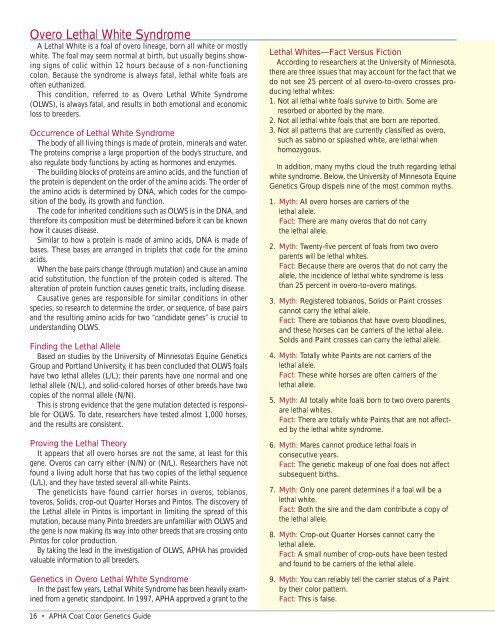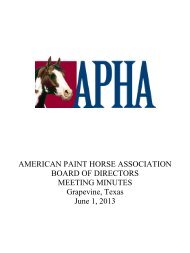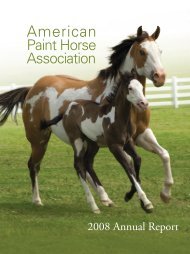Coat Color Genetics - Press - American Paint Horse Association
Coat Color Genetics - Press - American Paint Horse Association
Coat Color Genetics - Press - American Paint Horse Association
You also want an ePaper? Increase the reach of your titles
YUMPU automatically turns print PDFs into web optimized ePapers that Google loves.
Overo Lethal White Syndrome<br />
A Lethal White is a foal of overo lineage, born all white or mostly<br />
white. The foal may seem normal at birth, but usually begins showing<br />
signs of colic within 12 hours because of a non-functioning<br />
colon. Because the syndrome is always fatal, lethal white foals are<br />
often euthanized.<br />
This condition, referred to as Overo Lethal White Syndrome<br />
(OLWS), is always fatal, and results in both emotional and economic<br />
loss to breeders.<br />
Occurrence of Lethal White Syndrome<br />
The body of all living things is made of protein, minerals and water.<br />
The proteins comprise a large proportion of the body’s structure, and<br />
also regulate body functions by acting as hormones and enzymes.<br />
The building blocks of proteins are amino acids, and the function of<br />
the protein is dependent on the order of the amino acids. The order of<br />
the amino acids is determined by DNA, which codes for the composition<br />
of the body, its growth and function.<br />
The code for inherited conditions such as OLWS is in the DNA, and<br />
therefore its composition must be determined before it can be known<br />
how it causes disease.<br />
Similar to how a protein is made of amino acids, DNA is made of<br />
bases. These bases are arranged in triplets that code for the amino<br />
acids.<br />
When the base pairs change (through mutation) and cause an amino<br />
acid substitution, the function of the protein coded is altered. The<br />
alteration of protein function causes genetic traits, including disease.<br />
Causative genes are responsible for similar conditions in other<br />
species, so research to determine the order, or sequence, of base pairs<br />
and the resulting amino acids for two “candidate genes” is crucial to<br />
understanding OLWS.<br />
Finding the Lethal Allele<br />
Based on studies by the University of Minnesota’s Equine <strong>Genetics</strong><br />
Group and Portland University, it has been concluded that OLWS foals<br />
have two lethal alleles (L/L); their parents have one normal and one<br />
lethal allele (N/L), and solid-colored horses of other breeds have two<br />
copies of the normal allele (N/N).<br />
This is strong evidence that the gene mutation detected is responsible<br />
for OLWS. To date, researchers have tested almost 1,000 horses,<br />
and the results are consistent.<br />
Proving the Lethal Theory<br />
It appears that all overo horses are not the same, at least for this<br />
gene. Overos can carry either (N/N) or (N/L). Researchers have not<br />
found a living adult horse that has two copies of the lethal sequence<br />
(L/L), and they have tested several all-white <strong>Paint</strong>s.<br />
The geneticists have found carrier horses in overos, tobianos,<br />
toveros, Solids, crop-out Quarter <strong>Horse</strong>s and Pintos. The discovery of<br />
the Lethal allele in Pintos is important in limiting the spread of this<br />
mutation, because many Pinto breeders are unfamiliar with OLWS and<br />
the gene is now making its way into other breeds that are crossing onto<br />
Pintos for color production.<br />
By taking the lead in the investigation of OLWS, APHA has provided<br />
valuable information to all breeders.<br />
<strong>Genetics</strong> in Overo Lethal White Syndrome<br />
In the past few years, Lethal White Syndrome has been heavily examined<br />
from a genetic standpoint. In 1997, APHA approved a grant to the<br />
16 • APHA <strong>Coat</strong> <strong>Color</strong> <strong>Genetics</strong> Guide<br />
Lethal Whites—Fact Versus Fiction<br />
According to researchers at the University of Minnesota,<br />
there are three issues that may account for the fact that we<br />
do not see 25 percent of all overo-to-overo crosses producing<br />
lethal whites:<br />
1. Not all lethal white foals survive to birth. Some are<br />
resorbed or aborted by the mare.<br />
2. Not all lethal white foals that are born are reported.<br />
3. Not all patterns that are currently classified as overo,<br />
such as sabino or splashed white, are lethal when<br />
homozygous.<br />
In addition, many myths cloud the truth regarding lethal<br />
white syndrome. Below, the University of Minnesota Equine<br />
<strong>Genetics</strong> Group dispels nine of the most common myths.<br />
1. Myth: All overo horses are carriers of the<br />
lethal allele.<br />
Fact: There are many overos that do not carry<br />
the lethal allele.<br />
2. Myth: Twenty-five percent of foals from two overo<br />
parents will be lethal whites.<br />
Fact: Because there are overos that do not carry the<br />
allele, the incidence of lethal white syndrome is less<br />
than 25 percent in overo-to-overo matings.<br />
3. Myth: Registered tobianos, Solids or <strong>Paint</strong> crosses<br />
cannot carry the lethal allele.<br />
Fact: There are tobianos that have overo bloodlines,<br />
and these horses can be carriers of the lethal allele.<br />
Solids and <strong>Paint</strong> crosses can carry the lethal allele.<br />
4. Myth: Totally white <strong>Paint</strong>s are not carriers of the<br />
lethal allele.<br />
Fact: These white horses are often carriers of the<br />
lethal allele.<br />
5. Myth: All totally white foals born to two overo parents<br />
are lethal whites.<br />
Fact: There are totally white <strong>Paint</strong>s that are not affected<br />
by the lethal white syndrome.<br />
6. Myth: Mares cannot produce lethal foals in<br />
consecutive years.<br />
Fact: The genetic makeup of one foal does not affect<br />
subsequent births.<br />
7. Myth: Only one parent determines if a foal will be a<br />
lethal white.<br />
Fact: Both the sire and the dam contribute a copy of<br />
the lethal allele.<br />
8. Myth: Crop-out Quarter <strong>Horse</strong>s cannot carry the<br />
lethal allele.<br />
Fact: A small number of crop-outs have been tested<br />
and found to be carriers of the lethal allele.<br />
9. Myth: You can reliably tell the carrier status of a <strong>Paint</strong><br />
by their color pattern.<br />
Fact: This is false.




